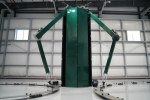At AUSA 2025 in Washington D.C., a new class of autonomous ground robots emerged as a potential game-changer in short-range air defense (SHORAD) operations. The Enhanced Autonomous Ground Layer Sensor (EAGLS) platform—developed by Teledyne FLIR Defense—demonstrated its capability to autonomously detect and track small unmanned aerial systems (sUAS), potentially transforming how forward-deployed units handle drone threats.
EAGLS: A Sensor-Rich Robotic Scout for the Modern Battlefield
The EAGLS platform is a lightweight unmanned ground vehicle (UGV) designed to operate semi-autonomously or fully autonomously in contested environments. It integrates high-performance electro-optical/infrared (EO/IR) sensors from Teledyne FLIR with onboard processing and AI-based object recognition algorithms. According to company representatives at AUSA 2025, the system is capable of persistent surveillance and autonomous detection of Group 1 and Group 2 UAS threats—typically quadcopters and fixed-wing drones under 25 kg.
Built on a ruggedized tracked chassis similar in size to other man-portable UGVs like the FLIR Centaur or QinetiQ Talon, EAGLS is optimized for mobility across urban and off-road terrain. Its low profile and quiet electric drive make it suitable for stealthy reconnaissance missions near the forward edge of battle areas (FEBA).
Key features include:
- FLIR Boson+ thermal camera with AI-enhanced target classification
- 360° EO/IR panoramic situational awareness
- Onboard NVIDIA Jetson-class edge processor for real-time analytics
- Mesh-networked communications compatible with ATAK and Nett Warrior
A Modular Approach to Counter-UAS Operations
EAGLS is not just a passive sensor node—it’s designed as a modular platform that can be integrated into layered C-UAS architectures. While it currently lacks an onboard kinetic effector or jammer, it serves as a forward-deployed “tripwire” that can cue other systems such as SHORAD vehicles (e.g., Stryker M-SHORAD), mobile jammers (e.g., DroneDefender), or directed energy weapons.
The robot’s autonomy stack enables it to patrol pre-defined routes or dynamically reposition based on threat vectors. When an aerial threat is detected via EO/IR signature analysis and acoustic cues, EAGLS can transmit precise targeting data—including bearing, elevation angle, and velocity vector—to networked shooters via Link-16 or proprietary mesh protocols.
This approach aligns with U.S. Army doctrine emphasizing distributed sensing and sensor-to-shooter integration under Joint All-Domain Command and Control (JADC2). In this context, EAGLS acts as an intelligent forward sensor node feeding into larger kill chains.
AI-Driven Threat Discrimination Capabilities
A critical challenge in counter-UAS operations is distinguishing between legitimate threats and clutter—such as birds or civilian drones. Teledyne FLIR claims that EAGLS leverages convolutional neural networks trained on extensive drone imagery datasets captured during live-fire exercises and controlled testing environments.
The system reportedly achieved over 90% classification accuracy during recent field trials at Yuma Proving Ground in mid-2025. It can differentiate between DJI-style quadcopters versus loitering munitions like the Iranian Shahed-136 clone variants based on IR signature profiles and flight behavior patterns.
This level of discrimination reduces false positives—a critical factor when operating near civilian populations or under restrictive rules of engagement (ROE). Moreover, its ability to operate without GPS input enhances resilience against GNSS jamming/spoofing tactics commonly employed by near-peer adversaries.
Integration with Tactical C4ISR Networks
EAGLS was built with interoperability in mind. It supports plug-and-play integration with tactical command-and-control platforms such as ATAK (Android Tactical Assault Kit), Nett Warrior tablets used by infantry squads, and vehicle-mounted Battle Management Systems (BMS).
This allows commanders at multiple echelons—from platoon leaders to brigade S2/G6 staff—to receive real-time alerts about UAS incursions detected by robotic scouts operating kilometers ahead of manned formations. The system’s use of open architecture standards also facilitates future upgrades such as LIDAR modules or RF direction-finding antennas for electronic warfare support roles.
AUSA Debut Signals Growing Demand for Robotic Forward Sensors
The unveiling of EAGLS at AUSA reflects broader trends within NATO militaries seeking cost-effective ways to extend situational awareness without risking personnel. With drone swarms increasingly used for ISR probing or kamikaze strikes—as seen in Ukraine—the need for persistent robotic sentries has become urgent.
The U.S. Army’s Rapid Capabilities and Critical Technologies Office (RCCTO) has reportedly expressed interest in evaluating EAGLS under its C-UAS prototyping initiatives. While no formal procurement contract has been announced yet, sources indicate that limited operational assessments could begin with select Infantry Brigade Combat Teams (IBCTs) by late FY2026.
Outlook: From Scout Bot to Shooter?
While current versions of EAGLS are unarmed scouts feeding data into larger kill webs, future iterations may incorporate hard-kill capabilities such as micro-missiles or directed energy modules if power constraints are resolved. Alternatively, teaming concepts could allow armed loitering munitions to be launched from nearby vehicles based on targeting data provided by EAGLS scouts.
If successful at scale—and hardened against cyber intrusion—the concept could redefine how ground forces secure airspace below 1 km altitude without relying solely on expensive radar-based systems or manned overwatch assets.
Conclusion
EAGLS represents a convergence of autonomy, AI-driven sensing, and tactical networking aimed squarely at one of today’s most pressing battlefield challenges: low-cost drone threats. Its modularity positions it well within evolving SHORAD ecosystems where speed-to-target matters more than ever. As doctrinal shifts toward distributed lethality continue across NATO forces, robotic scouts like EAGLS may soon become standard kit alongside rifle squads—not just experimental tech demos at trade shows.









